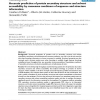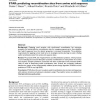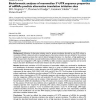1653 search results - page 14 / 331 » Adversarial Sequence Prediction |
COMPSEC
2004
13 years 7 months ago
2004
Identifying the intentions or attempts of the monitored agents through observations is very vital in computer network security. In this paper, a plan recognition method for predict...
BMCBI
2005
13 years 7 months ago
2005
Background: With the exponential increase in genomic sequence data there is a need to develop automated approaches to deducing the biological functions of novel sequences with hig...
BMCBI
2007
13 years 7 months ago
2007
Background: Structural properties of proteins such as secondary structure and solvent accessibility contribute to three-dimensional structure prediction, not only in the ab initio...
BMCBI
2006
13 years 7 months ago
2006
Background: Designing novel proteins with site-directed recombination has enormous prospects. By locating effective recombination sites for swapping sequence parts, the probabilit...
BMCBI
2008
13 years 7 months ago
2008
Background: Utilization of alternative initiation sites for protein translation directed by non-AUG codons in mammalian mRNAs is observed with increasing frequency. Alternative in...



